Langza Village is a culturally rich place located high up in the Spiti Valley in Himachal Pradesh. It is commonly known as a part of the Spiti circuit. Unlike the green areas of the lower Himalayas, Langza has a dry, cold, and mountainous environment that is very striking. It is a key stop for people traveling through Spiti.
The village is well-known for two main features: it is often called the “Fossil Village of India” because of the ancient marine fossils found here, and it is also famous for the large, beautiful Langza Buddha Statue that overlooks the valley. This village sits at a high altitude, making it a unique destination where you can see evidence of history from millions of years ago, alongside significant religious structures.

Table of Contents
Historical and Cultural Significance
Langza is located at an altitude of about 4,400 meters (14,435 feet). It is a traditional village that shows the culture and history of the Spiti region. The village’s identity is shaped both by its ancient geological past and its strong Buddhist faith.
The Village Parts: Langza Gongma and Langza Yongma
Langza, like many old villages in Spiti Valley, is split into two sections. This division gives an insight into how the community is organized.
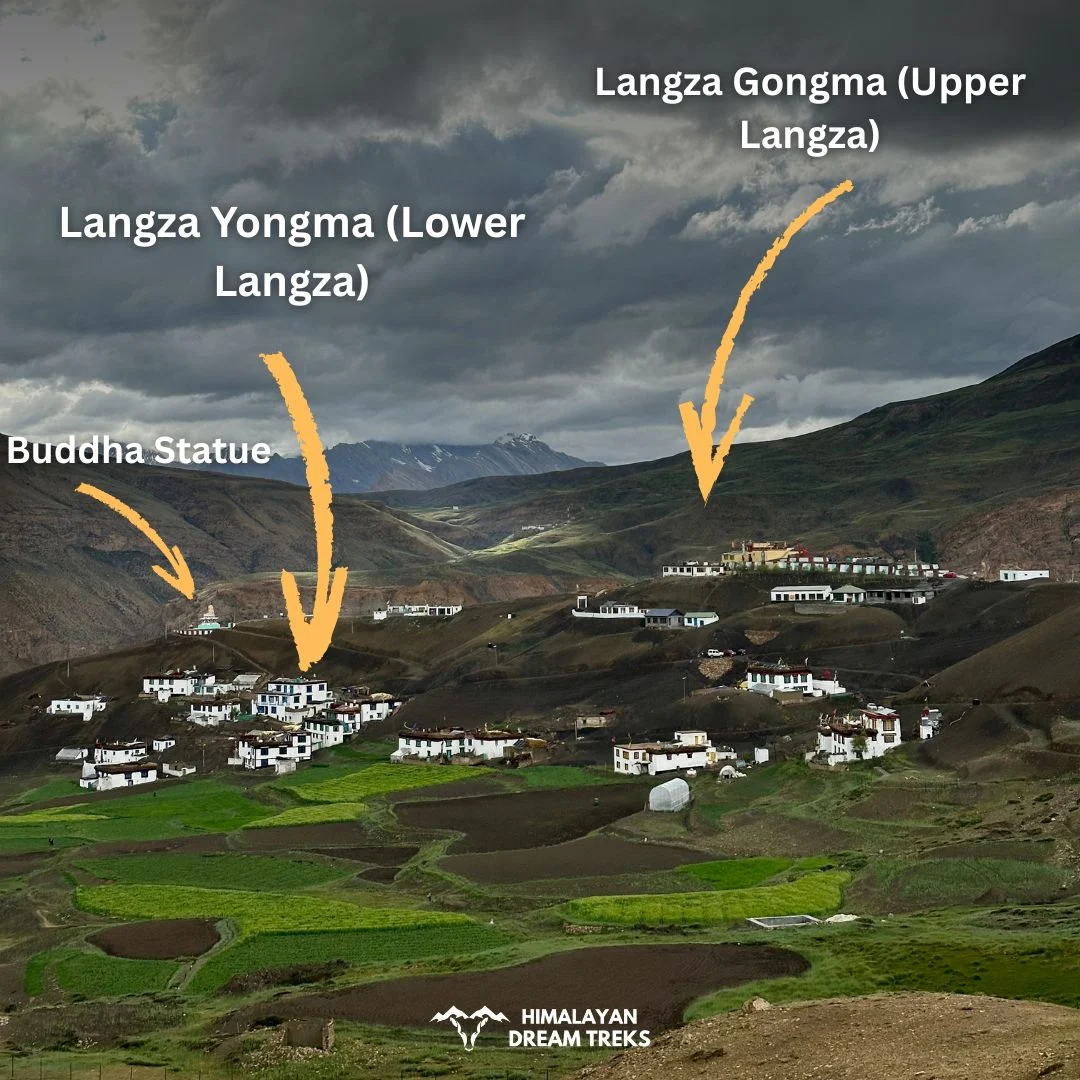
- Langza Gongma (Upper Langza): This is the higher part of the village. The large Buddha statue is located here. The higher location historically holds more religious importance. The old village temple, Lang, is also in this area.
- Langza Yongma (Lower Langza): This section is situated slightly lower down the slope. Most of the homes and farm fields are here. The architecture is typical Tibetan style, with houses built using mud, stone, and wood, designed to protect against the very cold winters. The colors—white walls, black doors, and blue windows—stand out against the mountains.
The village has a small population, only about 150 people living in 30 to 40 homes. They primarily earn their living from farming, most prominently growing barley and peas and raising winter animals like yaks and sheep. Their lifestyle shows a strong connection to nature and this is why they have a great ability to manage life in the tough environment.
Langza Gompa: The Main Village Temple
Even though the large Buddha statue is very famous, the old Langza Gompa (monastery), which locals call “Lang,” is extremely important spiritually. Located in Langza Gongma, this structure is believed to be over 1,000 years old.
The Lang Gompa is dedicated to the local protective deity named Lang Chenmo. The people of Spiti often consider the mountains and the spirits in them as a part of their religious belief, which is a mix of nature worship and Vajrayana Buddhism. When you visit the Gompa, which is a simple mud building, you can see the quiet ceremonies performed by the local monks. This spot is good for peaceful reflection, offering a quiet, spiritual feeling.
Chau Chau Kang Nilda: The Prominent Mountain
The highest peak visible above Langza is Chau Chau Kang Nilda. This impressive mountain, which is often snow-covered, is over 6,300 meters (20,670 feet) tall and seems to guard the village. From Langza, this peak provides one of the best views in the whole Spiti region.
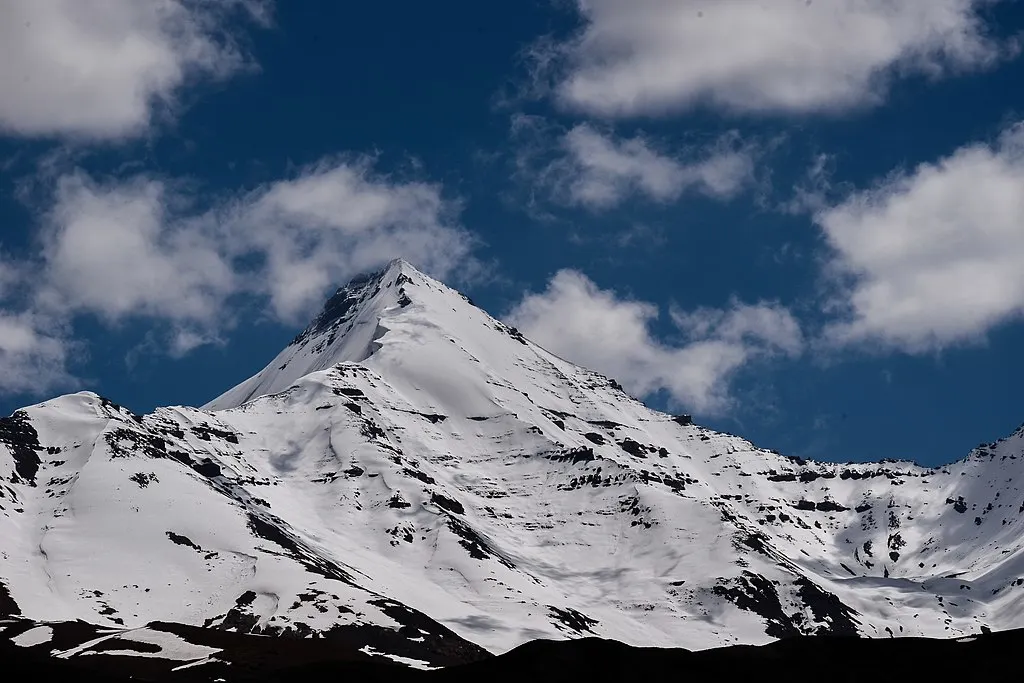
For the villagers, Chau Chau Kang Nilda is a sacred source of water as well. The constant snow and ice on its slopes create the clean streams that flow into the Langza valley. These streams are necessary for their limited farming and for drinking water. The sight of the morning sun hitting the peak and turning the snow bright is a beautiful moment that attracts many visitors. Its steady presence adds to the beautiful, clear landscape of the cold desert.
Langza: The Fossil Village of Spiti
The most unique fact about Langza, and the main reason many visitors, including geologists, come here, is its reputation as the “Fossil Village”. To understand why, you need to know the ancient geological history of the Spiti Valley.
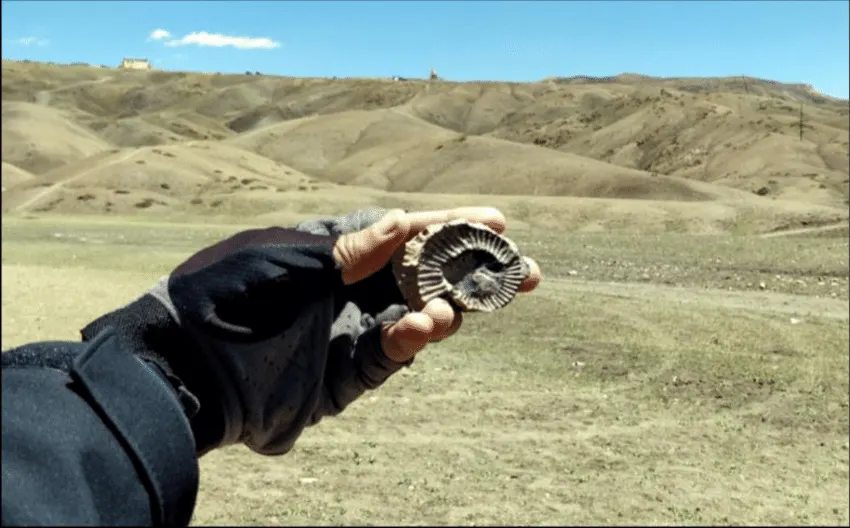
Connection to the Ancient Tethys Sea
Many millions of years ago, the land that now makes up this part of the Himalayas was completely underwater. It was covered by a large ocean called the Tethys Sea. This ocean separated the landmasses of Laurasia and Gondwana. About 50 to 70 million years ago, the Indian land plate crashed into the Eurasian plate. This huge geological event caused the Tethys Sea to close up, pushing the seabed upwards to form the Himalayas, the world’s highest mountain range.
Langza sits right in this ancient seabed area. The rocks around the village, which carry the rich history of over millions of years, contain many preserved remains of the marine life that lived in the Tethys Sea during the Mesozoic Era. This history is not hidden; the fossils are scattered across the fields and embedded in the rocks near the village.
Finding Chaudua: Fossils and Local Names
The fossils most commonly found in Langza are from ancient sea creatures called ammonites. These have spiral-shaped, chambered shells. They belong to a type of marine mollusk that is now extinct. Langza is particularly known for containing ammonoid fossils from the Triassic and Jurassic periods, which are an incredible 145 to 250 million years old. Locally, these spiral fossils are called “Chaudua.” The villagers, especially the children, are good at spotting these fossils, which often look like small, coiled shapes or a chakra (a wheel). Because they look like a chakra, these specific fossils are sometimes seen as sacred and referred to as Saligram (a holy, naturally occurring fossil stone). Finding a Chaudua is a chance to touch real history, holding a piece of the ancient ocean while standing on the top of the world.
Rules for Fossil Collection and Preservation
When Langza became popular, many people started collecting and selling the fossils without limits. To protect this important geological heritage, the Himachal Pradesh government has put a strict ban on collecting, removing, or selling marine fossils from Langza and the Spiti region without permission.
For travelers who care about the environment, this rule is a good step for preservation. You can still see and take pictures of the fossils in the ground, but you must follow the rule: “take only photos, leave only footprints.”
How to experience the fossils responsibly:
- Visit Local Displays: Some homestays and community places have small displays of fossils found in the region. This is the best way to learn about the geology without encouraging illegal collection.
- Support Zama Pottery: Instead of buying a natural fossil, look for local artists who make accurate copies of the ammonites using the traditional Zama mud craft technique. Buying these handmade items directly helps the local economy and traditional arts without damaging the fragile environment.
- Respect the Land: Treat the fields and rocks with great respect. Do not dig or try to break off embedded fossils. Your visit should help conserve, not destroy, this unique heritage.
The story of Langza’s fossils is a strong reminder that even the most distant parts of our planet hold stories much older than human history.
The Large Buddha Statue of Langza
The most recognized image of Langza Village is the very large, golden-colored statue of Lord Buddha standing on the hill above the homes. This huge figure is a clear symbol of peace and strength against the harsh mountain environment.
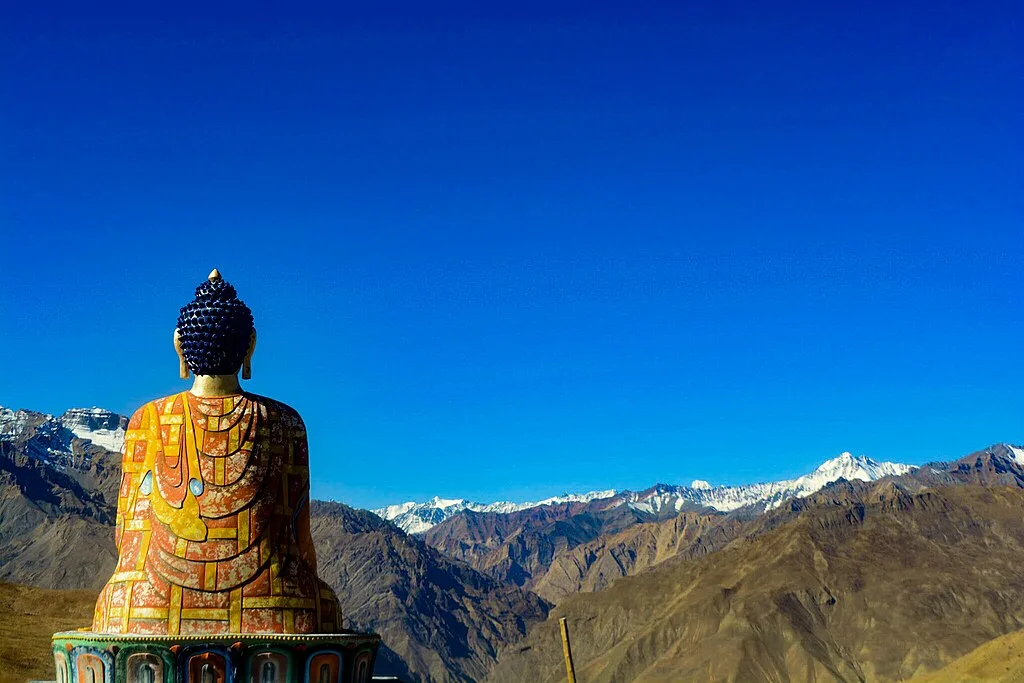
Maitreya Buddha: Meaning and Importance
The statue is a figure of Maitreya Buddha, who is known as the “Future Buddha.” In Buddhist belief, Maitreya is the spiritual leader who will come to Earth next and achieve full enlightenment, following the current Buddha. The size of this statue represents hope, peace, and the eventual enlightenment of the world.
The statue is about 20 feet tall and is placed so that it looks out over the mountains and the valley. It is seen as protecting the entire region of Langza and Spiti. Although the original shrine here is very old, the large structure you see now was built/re-established more recently. However, it perfectly represents the long-standing faith of the Spitian people. It is the highest structure in the village and its bright gold color stands out beautifully against the blue sky and the brown mountain landscape.
Finding Good Spots for Taking Pictures
The area around the Buddha statue is one of the most photographed spots in the whole Spiti Valley. Getting to the statue requires a short, easy walk or a 10 minute short trek from the parking area near the village.
- The Best Light: The best time for photos is during sunrise or sunset. At sunrise, the sun’s first light makes the statue glow warmly. At sunset, the last light hits the statue while the mountains behind it turn dark, creating a very strong visual contrast.
- Wide Views: From the statue’s location, you get an excellent view of the entire Langza area. You can see the different parts of the village, the farm fields, and the road coming up from Kaza. It is here that you understand how isolated and naturally beautiful this remote part of the Indian Himalayas is.
- Peace and Quiet: The spot is also good for spending some quiet time. The prayer flags (lungta) fly in the strong wind, carrying prayers across the valley. This creates an atmosphere of serenity and one can simply sit and enjoy the breeze making the flags dance.
The Best Time to Visit Langza Village
Dry seasons are undoubtedly the best time to visit Langza village. Spiti Valley and Langza experience very severe weather, and whether you can reach the village depends entirely on when the mountain passes are open. The two main access routes are the Manali-Kaza route and the Shimla-Kaza route.
The best time to travel is generally from May to October.
Summer (May to June)
Late spring and early summer offer the most stable and comfortable conditions for visiting Langza.
- Weather: Daytime temperatures are comfortable, usually between 15°C and 25°C. Nights are still cold, often dropping close to 0°C. The sky is very clear, which is great for photography.
- Roads: The Shimla-Kinnaur route (which is safer and open for longer) is fully accessible, making it easy to reach Kaza and Langza. The challenging Manali-Kaza route usually opens near the end of May or the beginning of June, after the heavy snow on Kunzum Pass has been cleared. Travelers visiting in early May should use the Shimla route.
- Activities: This period is the start of the trekking season. The fields around Langza begin to show some greenery, and visibility is excellent for seeing the Buddha statue and looking at the fossils. Homestays are fully ready for guests.
Autumn (September to October)
If you prefer cooler weather, very clear skies, and a landscape that is starting to change color, the months after the monsoon are ideal.
- Weather: Temperatures start to fall quickly, especially after mid-September. Expect daytime temperatures of 10°C to 18°C, and nighttime temperatures often fall below freezing, sometimes reaching -5°C to -10°C by late October. You must pack very warm clothes.
- Roads: Both the Manali and Shimla routes are usually open and in good condition after monsoon repairs. The biggest benefit of this season is the clarity of the sky. The rain clears the dust from the air, making September and early October the absolute best time for stargazing and night photography, which Langza is famous for.
- Crowds: The main rush of peak season (May-June) is over, leading to a quieter and more peaceful travel experience. This is good for travelers looking for solitude and real interactions with the local Spitian people.
Seasons to Avoid
It is important to know that traveling in the “off-season” in Spiti carries real dangers and access problems, especially for people traveling for the first time or driving their own vehicles.
Winter (November to April)
Langza, and the rest of Spiti, is mostly inaccessible and dangerous for normal tourism during winter.
- Extreme Cold: Temperatures can drop to -20°C to -30°C or even lower. Water freezes, and living can be very difficult because traditional homestays lack running water and central heating.
- Road Closure: The Manali-Kaza road (via Kunzum Pass) and sometimes even parts of the Shimla-Kinnaur road are closed because of heavy snow. Roads inside the valley, like the one to Langza from Kaza, can also be blocked by snow and ice for long periods.
- Limited Services: Most small shops, eating places, and some homestays close down. Phone signals are very weak, and help or emergency services are very slow or unavailable. While specialized winter trips exist, they require high levels of experience, special gear, and local guides, and are not for casual tourists.
Monsoon (July and August)
Although Spiti is a cold desert and gets less rain than the lower areas (like Manali or Shimla), the roads leading to it face the full impact of the Indian monsoon.
- Landslides and Blockades: The biggest problem in July and August is the frequent, large landslides on the Kinnaur route (NH-5). The road along the Sutlej river is risky, often causing road closures and delays that can last for days, ruining your travel plan.
- Manali Route: The Manali route is less affected by heavy rain but still difficult, with mud, slush, and high-flowing water crossings (Nallahs), making it especially tough for small cars or motorcycles.
Recommendation: For a trip that is easy and enjoyable, especially for Indian travelers, May-June or September-October is strongly recommended. The time from mid-June to mid-July is possible but be prepared for potential road delays.
Important Health Tips for High Altitude Travel
Traveling to Langza, which is much higher than most Indian towns, requires careful planning and respect for the altitude. Seasoned travellers are well aware of the situation but if you are heading towards the mountains for the first time, you might need to take extra care in this regard. Not preparing for the thin cold air can lead to Acute Mountain Sickness (AMS), which is a serious condition.
Acclimatization: The Most Important Step
For high-altitude travel, many Indian visitors often forget about AMS. As per anecdotes of recent Langza visitors, you can fairly enjoy the weather in summers without much woollen clothing after you have undergone proper acclimatization. For people who don’t, the weather gets a bit too harsh too handle. Getting used to the altitude is the single most important factor for a good experience in such an area. The following tips might help you in your journey:
- Go Slowly: Never rush the journey. Your body needs time to adapt to the lower oxygen levels at 14,000 feet.
- Mandatory Stops: If you take the Kinnaur route (Shimla side), you must plan to stay overnight at places that gradually increase in altitude:
- Rampur/Sarahan (lower altitude)
- Kalpa/Reckong Peo (about 9,000 feet)
- Nako/Tabo (about 10,000 to 11,000 feet)
- Kaza (about 12,500 feet) to Stay here for at least two full nights. Kaza is the best place to get used to the altitude before going to even higher villages like Langza (14,400 feet).
- During Your Stay: Drink lots of water (aim for at least 4 liters a day), avoid alcohol and too much coffee, and eat light meals that are high in carbohydrates. Avoid heavy physical activity on your first day in Kaza. If you get a constant headache, feel sick, dizzy, or short of breath, you must go down to a lower altitude immediately. Carry basic AMS medicine like Diamox (Acetazolamide) after talking to your doctor.
How to Reach Langza: A Complete Travel Guide
Langza is about 15 to 16 kilometers from Kaza, the main town of Spiti. While the distance from Kaza is short, the entire journey to Kaza from the lower plains is a major Himalayan trip. There are two main ways to reach it, each providing a very different travel experience.

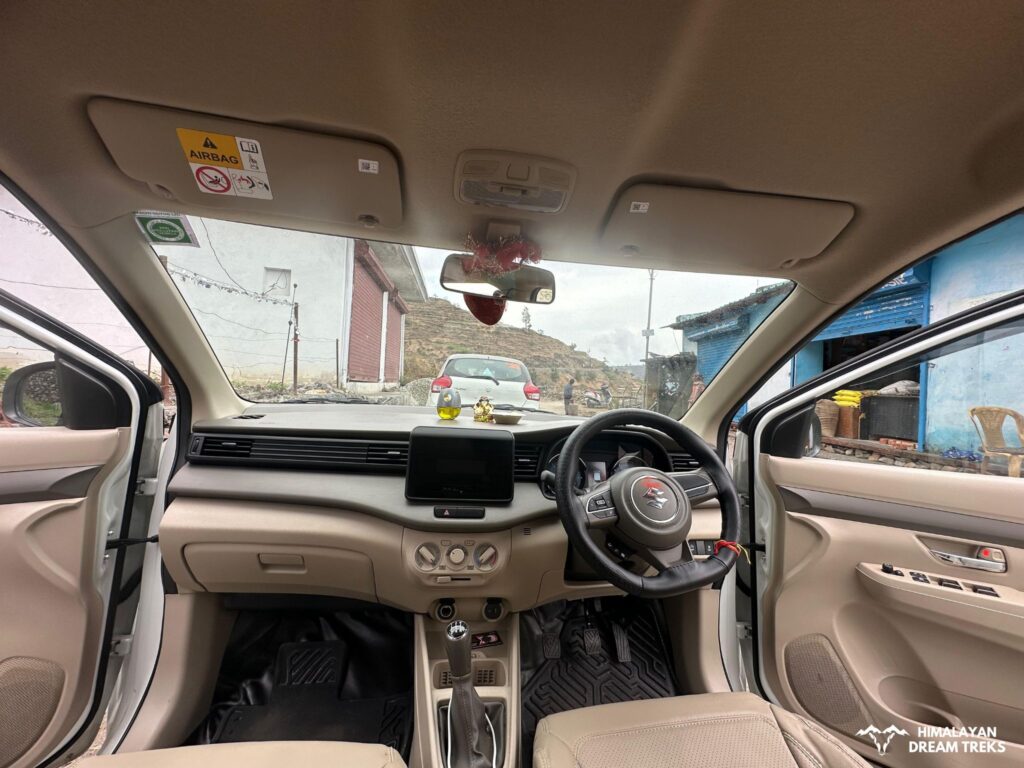
Route 1: The Kinnaur Route (Via Shimla) to Safer and Open Longer
This is the preferred route for most travelers, especially those who are new to high-altitude driving, because it allows you to get used to the altitude slowly and is open for more months of the year.
- Starting Point: Delhi/Chandigarh to Shimla.
- The Main Journey: Shimla → Narkanda → Rampur → Sangla/Chitkul (optional) → Reckong Peo/Kalpa → Nako → Tabo → Dhankar → Kaza (Rest here).
- Total Distance (Shimla to Kaza): Around 420 to 440 km.
- Travel Time: Recommended 3 to 4 days (necessary for safely adjusting to the altitude).
- Road Condition: The road is mostly paved but has a high risk of large landslides, especially near Kinnaur, during the monsoon. It is known for its challenging sections but offers impressive views along the Sutlej River. The section from Tabo to Kaza is one of the easier parts.
Detailed Travel Plan (3 Nights/4 Days)
- Day 1: Chandigarh/Shimla to Narkanda/Rampur Bushahr (7 to 8 hours). Altitude: Rises to 7,500 feet.
- Day 2: Rampur to Kalpa/Reckong Peo (6 to 7 hours). See the views of the large Kinnaur Kailash range. Altitude: Rises to 9,700 feet.
- Day 3: Kalpa to Tabo (8 to 9 hours). A long day spent passing through the challenging Khab (where the Sutlej and Spiti rivers meet). Stay overnight at Tabo to visit the old Tabo Monastery. Altitude: Rises to 10,760 feet.
- Day 4: Tabo to Kaza (3 to 4 hours). A short drive allows you to rest and get used to the altitude in Kaza in the afternoon.
Route 2: The Manali Route (Via Atal Tunnel) to Shorter but Difficult
This route covers less distance but is much harder to drive, and should only be attempted in the main summer season (June to September) when the passes are open.
- Starting Point: Manali.
- The Main Journey: Manali → Solang Valley → Atal Tunnel → Gramphu → Batal → Kunzum Pass (14,931 ft) → Losar → Kaza (Rest here).
- Total Distance (Manali to Kaza): Around 200 km.
- Travel Time: Recommended 2 days (Manali to Kaza with a stop overnight at Losar or Batal/Chhatru).
- Road Condition: This route is very difficult. The Atal Tunnel makes the start easier, but the road from Gramphu over Kunzum Pass is well-known for being rocky, rough, dusty, and having many deep water crossings (locally referred to as Naalas) that can be hard for cars with low clearance.
Crucial Warning on Acclimatization for the Manali Route
Traveling from Manali (6,700 ft) directly to Kaza (12,500 ft) or even higher to Langza (14,400 ft) in just one day is a high risk for AMS. The quick gain in altitude is dangerous. It is highly advised to stop overnight at Losar or Batal to let your body adjust. If you choose this route, make sure you are healthy and have enough time to rest once you reach Kaza. This route is typically only open from the end of May/early June until early October.
Getting to Langza from Kaza: Local Travel Methods
Once you are in Kaza, Langza is only 15 to 16 km away, but the drive is uphill and on very rough roads.
- Local Taxi: This is the simplest and most reliable choice. Local taxis (like a Maruti Gypsy or similar high-clearance cars) are easy to find in Kaza. You can hire one for a day trip to the Langza to Komic to Hikkim circuit. This is recommended because the drivers know the rough roads well.
- Self-Drive: If you drive your own car, it should have high ground clearance (an SUV is better), and you must be comfortable driving on steep slopes, sharp turns, and very uneven, rocky roads.
- Local Bus/Shared Taxi: The HRTC runs a limited bus service that connects Kaza to the high villages like Langza and Komic. However, you cannot be sure about the timing and frequency. Shared taxis (carrying 6-8 people) are the cheapest option and can be found near the Kaza bus stand, offering a local travel experience where you get to find new friends as well.
- Trekking: For those who like trekking and are physically fit to do so, you can take a scenic, moderate trek from Kaza to Langza. This takes about 4-5 hours and is a great way to see the landscape, but only do this if you are fully used to the altitude and fit enough.
Places to Stay in Langza
Langza is not a commercial tourist spot. You will not find large hotels or expensive resorts here. The places to stay are few, very local, and truly show the culture of Spiti: the Homestay.
Staying in Homestays: The Local Experience
The few homestays in Langza offer a close and unique cultural experience. Staying here means you live the traditional life of a Spitian family for the time you are there. Accommodation in Langza Village is primarily centered around genuine, family-run homestays, providing a cultural experience rather than a hotel stay. Since the village is remote and high in the Spiti Valley, travelers should expect facilities to be simple but warm, focusing on necessity over luxury. The following options are worth exploring:
- Lara’s Homestay
One of the most well-known and often highly-rated options is Lara’s Homestay, which sometimes operates under the general name of Langza Homestay and offers a slight upgrade in comfort compared to others. This homestay usually features 5 to 6 rooms and may include Deluxe options with attached western-style bathrooms, a considerable amenity in this region. Guests benefit from solar water heating and the communal warmth provided by a central bukhari (wood-fired stove) in the common area, along with access to purified drinking water. The estimated full package price for a stay here generally falls between Rs 2,500 and Rs 3,500 per night, depending on the room type and specific inclusions.
- Phan Dhey Homestay
For visitors prioritizing the scenic location, Phan Dhey Homestay is a popular choice, known specifically for its fantastic views overlooking the majestic Buddha Statue and the towering Chau Chau Kang Nilda peak. This homestay offers a more traditional, simple experience, focusing on clean rooms and the warmth of a family home. The facilities are basic, with access to shared or simple private bathrooms, and the pricing is typically in the mid-range for the village, estimated between Rs 1,800 and Rs 2,500 per night including the required Spitian meals.
- Nawang Homestay
Nawang Homestay is a reliable choice in the mid-range segment, often utilized by local tour agents for its clean and dependable service. It provides simple, spacious rooms and is a good base for travelers who need a standard, consistent experience. Its facilities include clean rooms, a dedicated dining area, and it focuses strongly on providing the traditional village experience. Its estimated pricing usually sits between Rs 1,500 and Rs 2,200 per night including dinner and breakfast.
- Tsewang Homestay
For the most authentic and budget-friendly experience, travelers often look for options like Tsewang Homestay, which represents the smaller, highly traditional family homes in Langza. These homestays prioritize cultural exchange over modern amenities. Expect clean, very basic rooms with multiple layers of warm blankets, shared toilet facilities (often Indian-style), and hot water provided only in buckets upon request. The estimated price range for these very basic, family-run stays is lower, generally between Rs 1,200 and Rs 1,800 per night.
You need to be careful of the fact that cash is the only accepted form of payment, and services like central heating, reliable electricity, or continuous hot running water are not available due to the village’s remote setting and extreme climate. In spite of such hardships, you can expect complete support and adequate help from the homestay owner or the caretakers. Additionally, mobile and internet connectivity is minimal or non-existent in Langza, making the natural experience free of constant notifications.
Things to Do in Langza: Craft, Food, and Activities
Langza is a place where you should take your time, and break the monotony of regular routine. The best experience here is not just checking off tourist spots but spending time enjoying its quiet environment, its history, and its unique cultural products.
Zama Pottery: The Traditional Clay Craft
Before farming became the main source of income, the old craft of Zama Pottery was the primary job of the people in Langza. This unique craft started in Spiti Valley because of the specific yellow and black clay found nearby.
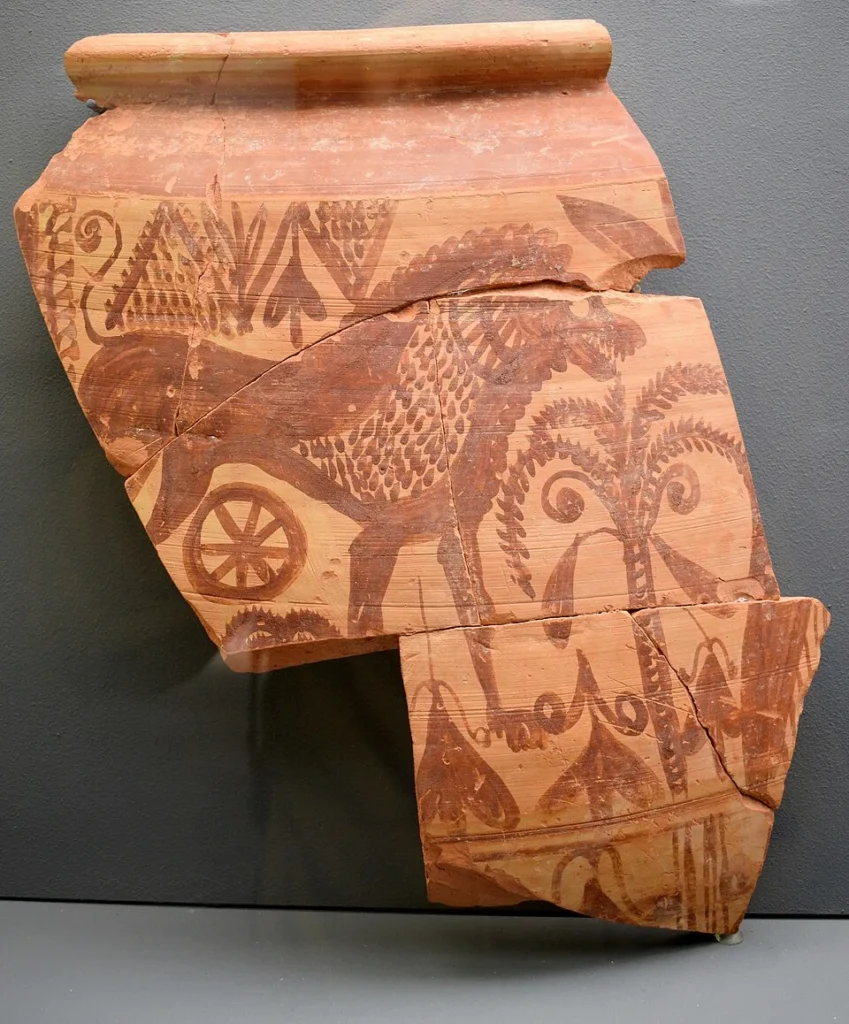
- The Process: Zama involves making useful and decorative items—from butter lamps (choema) to storage pots and small figures—using this local clay. In the past, every house used clay utensils for cooking and storage.
- Today’s Status: When metal and plastic items became common, Zama pottery became less necessary and was at risk of disappearing. However, due to tourism and a renewed interest in old arts, some families in Langza still practice this skill, which has been passed down for many generations.
- A Good Souvenir: When you visit, try to meet the local Zama artists (your homestay host can usually help you find them). It is interesting to watch them work with the clay. Buying a small handmade item—like a copy of a fossil or a small pot—is the best way to help preserve this old art form.
Eating Authentic Spitian Food
The food in Langza is simple, fulfilling, and perfectly suited to keep you warm and healthy at high altitudes. The cooking is heavily influenced by Tibetan flavors, using staple foods like barley, peas, and potatoes, which grow well during the short farming season.
- Thukpa: A very hot, comforting noodle soup, usually served with local vegetables (peas, carrots, potatoes) and spices. A bowl of homemade thukpa is perfect after a cold day of walking.
- Momos: Steamed or fried dumplings, often filled with minced meat (mutton/yak) or local vegetables, served with a spicy red chili sauce (chutney).
- Tsampa (Roasted Barley Flour): A main food item, sometimes mixed with butter tea and eaten. It is very nutritious and used to make local bread.
- Spiti Bread: A large, fried, raised bread, often eaten for breakfast with jam or butter. It is light and tasty.
- Butter Tea (Salty Tea): Called Cha or Sua Cha locally, this traditional Tibetan tea is made with yak butter and salt. It may taste different than normal tea, but its high-fat content is very helpful for dealing with the cold and dry air at high altitudes.
Homestays usually provide both dinner and breakfast, giving you a chance to taste this healthy, local Spitian food, grown right in the fields near the village.
Stargazing and Night Photography at Langza
A visit to anywhere in and around Spiti valley remains incomplete without stargazing. You might have come across various reels from travel influencers enticing you with the night sky from their cottage, tent, etc. Langza’s remote position, high altitude, and lack of street lights (and thus, no light pollution) make it an excellent location for looking at the stars and taking night photos.

- The Milky Way: On a clear night without much moonlight (especially in September or October), the sky above Langza becomes a stunning view of the universe. The Milky Way Galaxy is often clearly visible with just your eyes, stretching across the dark sky like a bright river. On the other hand, if you happen to visit around the full moon, gazing at the moon and its illuminance is also a once in a lifetime experience.
- Astrophotography: Many photographers come here to take pictures of the stars, the Milky Way, and the large Langza Buddha statue against the bright, starry sky. The complete silence of the night, only broken by the wind, makes the experience of seeing the universe feel very special.
- The Mountain’s Glow: On nights with a full moon, the snow on the Chau Chau Kang Nilda peak glows softly, giving the landscape a unique, blue light.
Nearby Places to Visit
Langza is situated perfectly to be part of a popular day-trip loop with two other famous Spiti villages: Komic and Hikkim. These three high-altitude villages, all easy to reach from Kaza, represent the unique, record-holding appeal of the Spiti Valley.
Komic Village: One of the Highest Villages with a Road
Just a short, winding drive from Langza (about 6 to 7 km) is Komic, situated at an even higher elevation of about 4,587 meters (15,049 feet). Komic is often claimed to be one of the highest motorable villages in the world where people live permanently.
- Tangyud Gompa: Komic is home to the ancient Tangyud Monastery (Gompa), which is one of the highest monasteries in the Spiti region. This monastery dates back to the 14th century and belongs to the Sakya school of Tibetan Buddhism. Its structure looks like a fortified castle, protecting it from weather and invaders. The monastery provides a great view of the Komic valley below.
- The Highest Eatery: Travelers often eat at the local Spiti Organic Kitchen. Although its claim to be the highest restaurant in the world is often debated, having hot thukpa at this altitude is a very memorable experience.
Komic gives you a stronger feeling of high-altitude life—the air is noticeably thinner, and the size of the mountains all around is huge. The village itself is small, with only a few traditional mud-and-stone houses located below the old Gompa.
Hikkim Village: The World’s Highest Post Office
Driving a little way down from Komic and near Langza, you reach Hikkim Village. This village is known worldwide for one main building: the Hikkim Post Office. Located at about 4,440 meters (14,567 feet), it is officially the highest working post office in the world.
- The Postcard Tradition: The main thing to do in Hikkim is to send a postcard home or to someone you know. The post office is a small, traditional building run by a postmaster. Writing a postcard and getting it stamped with the unique Hikkim seal is a must for every visitor. This simple action connects one of the most remote parts of the planet to the rest of the world, giving you a physical memory of your journey to the high desert. For Indian travelers, it is a nice connection to the older, non-digital way of communication.
- The Last Stretch: The road from Hikkim back to Kaza is short and scenic, completing the high-altitude travel circuit in this area of the Spiti Valley.
Kaza: The Main Town and Supply Center
No guide to Langza would be complete without talking about Kaza, which is the central point for the whole Spiti Valley. Langza is typically visited as a day trip from Kaza.
- Base for Travel: Kaza, at 12,500 feet, is where most travelers spend their important days getting used to the altitude. It has the best facilities in the valley: the main petrol pump, the only reliable ATMs, the largest market, car repair shops, the bus station, and the widest choice of hotels and guesthouses.
- Key Monastery (Ki Gompa): Kaza is also the starting point for visiting the very large Key (Ki) Monastery, the most famous monastery in the valley. It is known for its dramatic hilltop location and its many old paintings, scriptures, and artifacts.
Conclusion
The trip to Langza is a journey that connects you with time – the past, the future, and the present. Here, you can embrace the beautiful geographical and cultural history in three clear ways: geological past of the Tethys Sea, the spiritual timelessness of the Maitreya Buddh, and the simple, ongoing present, shown by the tough, kind people of Spiti.
It is not just about adventure or visiting a place; it is about changing your perspective. It is about learning to manage with little – away from 5 minute delivery apps and other facilities, appreciating the simple warmth of a fire in a cold place, and valuing the quiet, strong link between people, faith, and the deepest parts of the Earth. Go, and discover a part of history that leaves an everlasting imprint on your heart! Even though Langza offers a wholesome experience in itself, it is advisable to do the full Spiti circuit in a single stretch to further enhance your experience.
Team Himalayan Dream Treks regularly organizes Himachal village tours and the Spiti Circuit. You can check our offerings or contact us directly at info@himalayandreamtreks.in
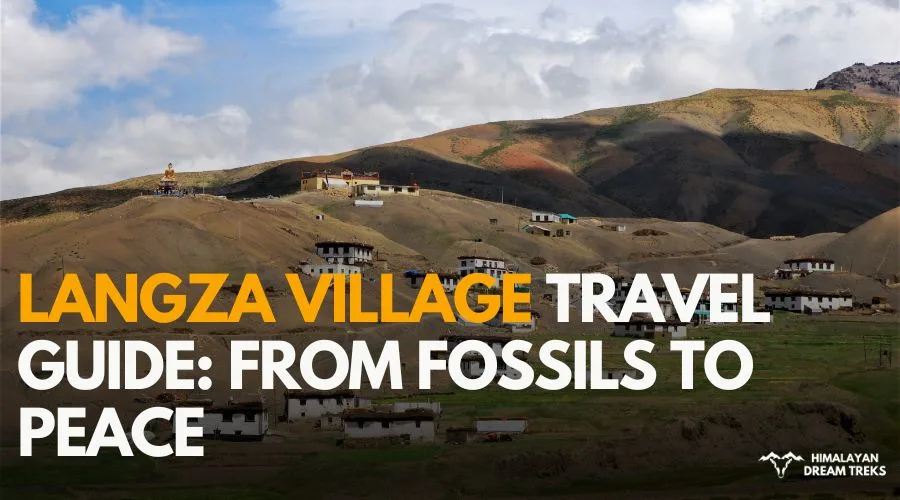
Leave a Comment